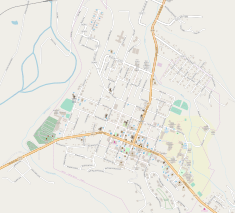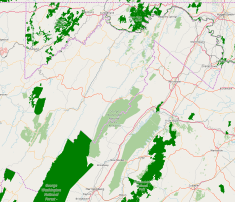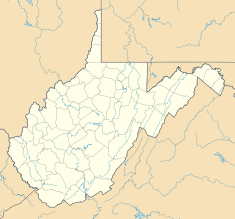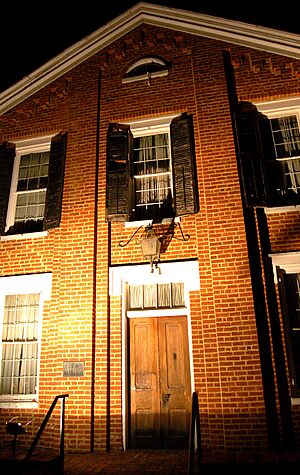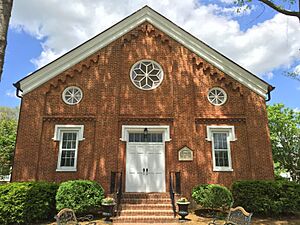Literary Hall facts for kids
Quick facts for kids |
|
|
Literary Hall
|
|
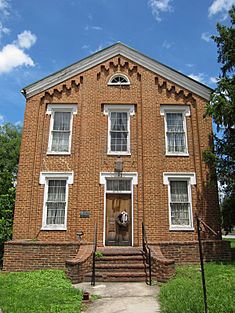
Literary Hall, viewed from the south, facing West Main Street in Romney
|
|
| Location | West Main & North High Streets Romney, West Virginia, United States |
|---|---|
| Area | Less than 1 acre (0.40 ha) |
| Built | 1869–70 |
| Architectural style | Federal, Greek Revival, Victorian |
| NRHP reference No. | 79002577 |
| Designated | May 29, 1979 |
Literary Hall is an old brick building in Romney, West Virginia. It was built between 1869 and 1870. This historic place has been a library, a meeting spot, and even a museum. You can find it where North High Street (West Virginia Route 28) meets West Main Street (U.S. Route 50).
The building was first constructed by a group called the Romney Literary Society. This society was very important for learning in West Virginia. It was one of the first groups of its kind in the whole United States. They had a large library with about 3,000 books.
During the American Civil War, many of the society's books were lost or destroyed. After the war, the society worked hard to rebuild. They built Literary Hall to create a new library and continue their activities. Later, the building was used by other groups, like the Masons, and even housed a public library for a while. Today, Literary Hall is recognized as a special historical site. It was added to the National Register of Historic Places on May 29, 1979.
Contents
Where is Literary Hall?
Literary Hall is right in the middle of downtown Romney, West Virginia. It sits at the corner of North High Street and West Main Street. The building is on a small piece of land, less than one acre in size.
Right next to it, across North High Street, is the Hampshire County Courthouse. The Romney First United Methodist Church is just north of the building. Literary Hall stands about 820 feet (250 meters) above sea level.
The Story of Literary Hall
The Romney Literary Society
The Romney Literary Society was a group of nine important men who started it on January 30, 1819. This society was the first group focused on literature in what is now West Virginia. It was also one of the first in the United States.
In 1819, they started their library with just two books. By 1861, their library had grown to about 3,000 books. These books covered topics like literature, science, history, and art. The society also helped start the Romney Classical Institute, a school for higher education.
Both the society and the school were very successful until the American Civil War began in 1861. During the war, many of the library's books were taken or ruined by soldiers. After the war, only about 400 books could be found.
The Romney Literary Society started up again on May 15, 1869. They decided to build Literary Hall to create a new library and bring back their activities. They also helped bring the West Virginia Schools for the Deaf and Blind to their old school campus. The new library at Literary Hall opened with 700 books. For about ten years, Literary Hall was a central place for learning in Romney. The society's last meeting was held in 1886.
The Clinton Lodge Masons
After the Romney Literary Society stopped meeting, another group used Literary Hall. This was the Clinton Lodge of Ancient Free and Accepted Masons. This group was one of the first Masonic lodges in Hampshire County, West Virginia.
The Masons used the first floor of Literary Hall for their meetings. The Romney Literary Society had used the second floor as their library. The Masons and another group called the Order of the Eastern Star continued to use the building for many years.
In 1973, a lawyer named Ralph Haines bought Literary Hall. He wanted to save the old building from being torn down. He also gave the Masons land to build a new meeting place. Mr. Haines then fixed up Literary Hall and used it as his law office and a private museum. He later moved his law office, but the building remained a special place.
A Community Library
Literary Hall also served as a community library again starting in March 1937. Before this, the library was in the basement of the Hampshire County Courthouse. It was started by the American Legion Auxiliary in 1935.
When the library's collection grew too big for the courthouse basement, the Masons allowed it to move to Literary Hall. The library then opened for more hours each week. This was possible with help from groups like the National Youth Administration.
In 1942, the library moved again to the Hampshire County Courthouse. Later, in 1967, a brand new Hampshire County Public Library building was opened. The land for this new library was given by sisters Kate and Mary Davis. Their father had been a member of both the Romney Literary Society and the Clinton Lodge Masons.
What Literary Hall Looks Like
Literary Hall is a two-story building made of red brick. It has a rectangular shape and a sloped roof. The inside and outside of the building still look much like they did when it was first built.
The building mixes different styles of architecture. It has parts that look like early American designs, but also details from the Victorian era. This mix makes it quite unique.
Experts say Literary Hall is a very important landmark in Romney. It shows how education and literature grew in the early United States. The building also adds a special look to Romney's main street.
The first floor of Literary Hall has four rooms. The second floor is one large room, like a ballroom. The outside has decorative moldings and brick patterns that are typical of the Victorian style.
The front of Literary Hall has three sections, and the sides have five sections. Each section has a tall wooden window with nine glass panes. These windows have white wooden shutters. The bricks are laid in a pattern called "American bond."
At the top of the front of the building, there's a simple wooden trim. There's also a half-circle window in the middle of the roof's peak. This window lets light into the attic. It might have been inspired by an older courthouse window.
The windows and the main entrance have white wooden decorative frames. The main entrance has a tall double wooden door with its original handle. Above the doors, there are four vertical glass panels that let in light. Outside the entrance, there's a brick porch with steps leading up to it.
Literary Hall has two chimneys on its sides. The building sits on a foundation made of sandstone blocks. Its roof is covered with metal sheets.


